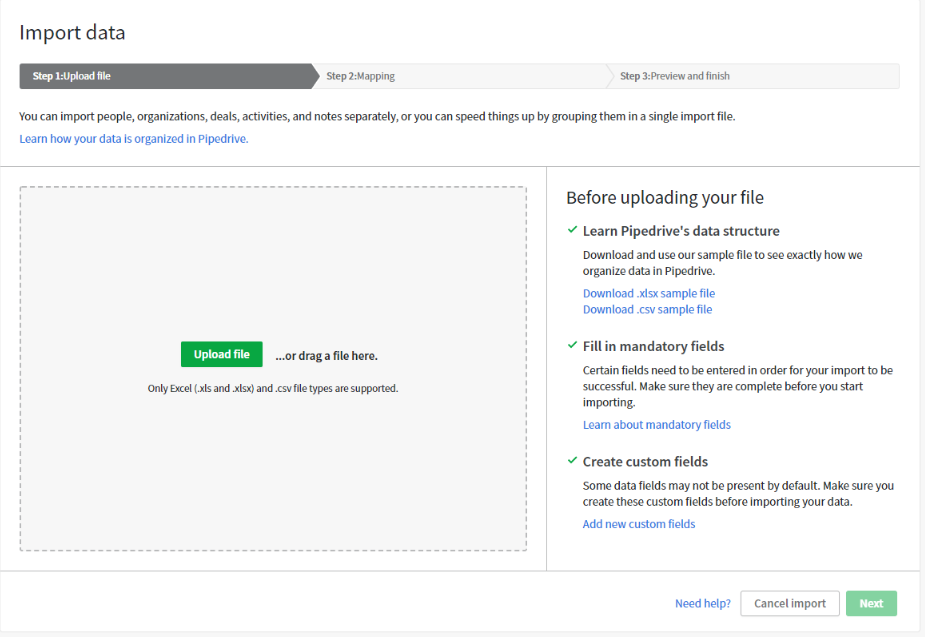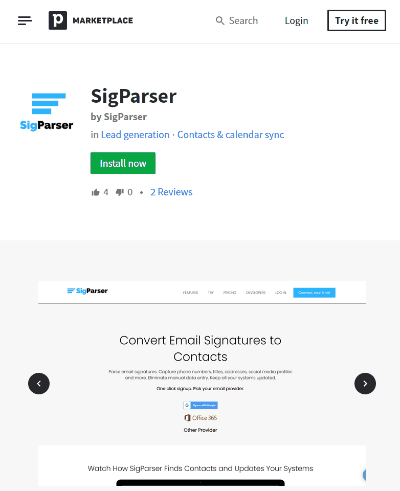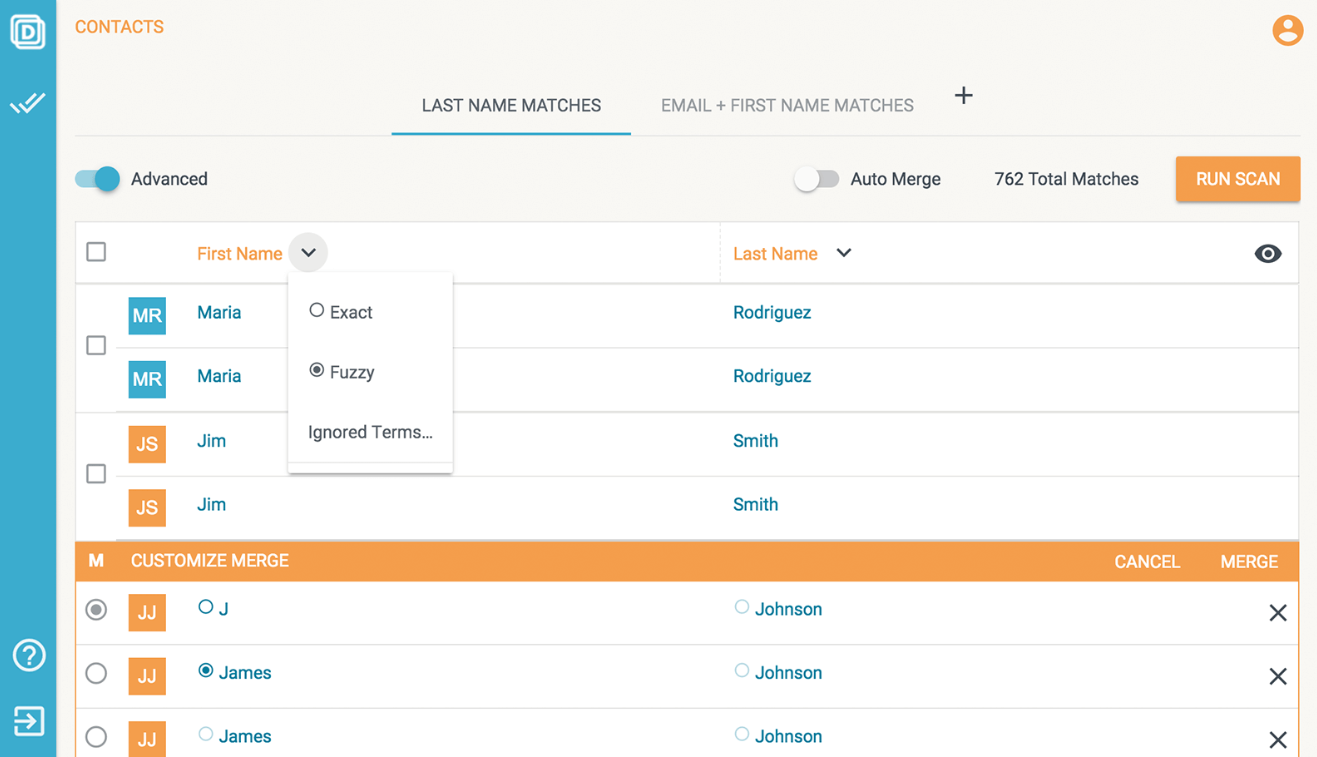Pipedrive is a great sales tool but it needs data.
Specifically, Pipedrive needs contacts.
Whether you’ve been using Pipedrive for years or just started, you probably know you don’t have all the contacts you’ve been dealing with.
If your business has more than one person dealing with customers and prospects then you’ve got a contact management problem.
How do you find contact details today? You probably have 3 or 4 systems you go to.
What’s that guy’s number? What’s her title?
Your relationships are the lifeblood of your business and should all be in Pipedrive.
What We’ll Cover
In this guide you’ll learn how to load your Pipedrive CRM by gathering, cleansing, importing and deduping contacts and how to keep them automatically up to date in the most efficient way possible moving forward.
- Gather Data Sources
- Prepare Your Data
- Import Contacts to Pipedrive
- Scrape Email Signatures
- Deduplicate Contacts
- Automatically Update Contacts
Gather your sources of contact data
Does the following sound familiar?
You have key contacts in your Google Contacts but not your CRM. You and your team also have contacts in your CRM. You’ve also got a bunch of Excel files your marketing or sales team has collected over the years. Finally, you’ve got a ton of important contacts still stuck in your email that no one ever entered anywhere (they just keep searching their inbox to contact them) but are really important.
Where to start?
You could spend hours looking for every file or source that ever existed but your best bet is to actually pull together most valuable sources you can think of. They are probably easily identifiable, at the least the most important ones, so best to start there.
We think your current CRM (if you are loading Pipedrive for the first time), your Google/Office 365 contacts and your email contacts are probably the most valuable starting points.
Below we’ve identified other sources that might be of interest to you as well. Each business has different data sources and criteria for important contacts. You’ll need to decide which of those data sources are important for your business.
Your first step should be to export contacts from the systems they’re stored in to Excel or CSV:
- Google Contacts
- Open Google Contacts, click More on the left panel, click Export as Outlook CSV
- If you choose Google CSV it is much harder to map phone numbers later.
- Outlook & Office 365 Contacts
- Emails and email signatures via SigParser
- SigParser automatically converts years of you or your team’s emails into a database of contacts, phone numbers, and titles. This data can integrate directly with Pipedrive or be exported to an excel file.
- Personal CRM systems like ACT
- Your company billing system like Stripe or PayPal
- Excel or CSV files of those contacts you got from marketing for a conference last year
Prepare Your Data Files For Migration (Optional)
Before you go importing contacts, you’ll want to do some basic data cleanup and categorizing. We’ll create a single spreadsheet and then show you how to bring together your sources before importing to Pipedrive.
Create a Master sheet with your best data
We suggest doing this for your highest quality data sources like your CRM system and maybe some high quality Excel or CSV files with contacts.
First, create a Master spreadsheet with the following columns like so:
- Source - Where the rows came from (Google, outlook, CRM, Excel file name, etc)
- Email Address
- First Name
- Last Name
- Work Phone
- Mobile Phone
- Title
- Company
- Any other custom fields you need
Then go through each of the Excel and CSV files you have from other systems and do the following:
- Add a Source column and set every row’s value to the name of the spreadsheet.
- Pick a specific font color for that source, it will help later when trying to clean up the data
- Delete columns not defined in the Master spreadsheet
- Rename the remaining columns to match the ones in the Master spreadsheet
- Reorder the columns so they have the same order as the Master spreadsheet
- Copy all the rows of data except for the header row (1st row with First Name, Last Name, etc)
- Paste those rows into the Master spreadsheet
- Repeat these steps for each of your export files.
Now we’re going to do some light data cleansing of the Master sheet.
You don’t need to delete duplicate email addresses. There are tools that will handle that for you later on in the process. For now, we just want to make sure when a single email address is assigned to multiple different phone numbers or titles that we’re picking the best ones.
The below process will get the Excel file into a format that makes it easy to identify the duplicate email values
- In Excel sort on the Email Address column, to do this:
- Select the Email Address column
- Then in the Data tab -> click Sort (A-Z or Z-A, whichever you prefer)
- Go to the Home tab, select the email address column again, click Conditional Formatting -> - Highlight Cell Rules and then Duplicate Values and then click OK
This will now highlight the duplicate cell values for email address like the screenshot below:

The next step is to remove all the blank cells so you can easily see the multiple phone numbers you have assigned to the same email address
- Select all the rows and columns by clicking the top left of the sheet
- In the Data tab click Filter so you get the filter options on the column headers

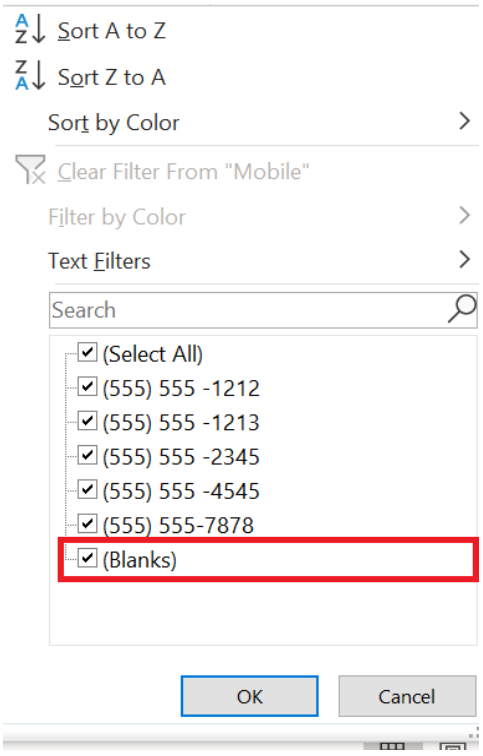 Then for each of the columns (Title, mobile, etc) you can go through one by one, pick the filter arrow and uncheck the **blanks** option (you may have to scroll a bit to find it) which will remove all the blank cells from the results.
Then for each of the columns (Title, mobile, etc) you can go through one by one, pick the filter arrow and uncheck the **blanks** option (you may have to scroll a bit to find it) which will remove all the blank cells from the results.
You should now have something like the below image.
You can now scroll through the list and any email address with multiple phone numbers are easily identified in red. The row color coding will help you identify which source the data came from. Any place you see two different phone numbers for a single contact that conflict, you can delete the one that is incorrect or leave both to let them both be imported into Pipedrive.

Import Contacts Into Pipedrive
When loading your CSV and Excel files, Pipedrive makes it easy to map your data to Pipedrive fields.
If you have multiple files to load into Pipedrive thats okay. Pipedrive will allow you to map each of those files independently to the proper fields in Pipedrive. Pipedrive has great documentation on how to think about the various import strategies you might use. Again, for this article we are focused on contacts only, but you may use another one of the strategies above.
Since you have one Master spreadsheet file from all your data sources (old CRM, Google Contacts, etc) then you’ll have a little bit less mapping and cleanup to do in Pipedrive.
Are you migrating to a brand new Pipedrive instance?
The good news is you have the opportunity to make a clean start with good data. If there are issues with your first import, no problem, you can just start all over again. After all, you haven’t really used the data yet so there have been no updates and if you notice any issues you can just reload all your data and fix the issues you see.
Importing to an existing Pipedrive instance
If Pipedrive is already your official CRM and you are doing this process after Pipedrive has been in use, that’s okay. The amount of data you may have from Google/Office 365 contacts will probably be much less than what you have in Pipedrive so it should be easier to ensure you have a clean high quality list negating the need to wipe out any data you do add.
If you make a mistake with your import you can always roll it back.
Before you import anything into your official Pipedrive account, we suggest trying the import with a trial account. You can make a new Pipedrive Company here. Try the imports and then delete trial account once you’re done. This way you don’t risk making a mistake and corrupting your full Pipedrive set of contacts.
Upload Your Pipedrive File Steps
Let’s start with your most trusted sources of data for your first upload
- Go to Settings > Tools > Import data > From file.
- Click Upload file and select the file that you intend to import. Pipedrive supports Excel (.xls and .xlsx) and .csv files.
Tip: Max File Sizes for Pipedrive UploadsThe maximum file size is limited to 50mb, with a maximum limit of 50,000 rows within the spreadsheet.

The next step is to map your fields in Pipedrive to your Excel or CSV file fields. You just need to select the Pipedrive fields on the right and map them to your spreadsheet fields on the left. You can toggle between Contacts, Organizations, Deals, Meetings and Notes.
Tip: Create a Title field in PipedrivePipedrive doesn't come with a title field. You need to add that onto the Contact type.
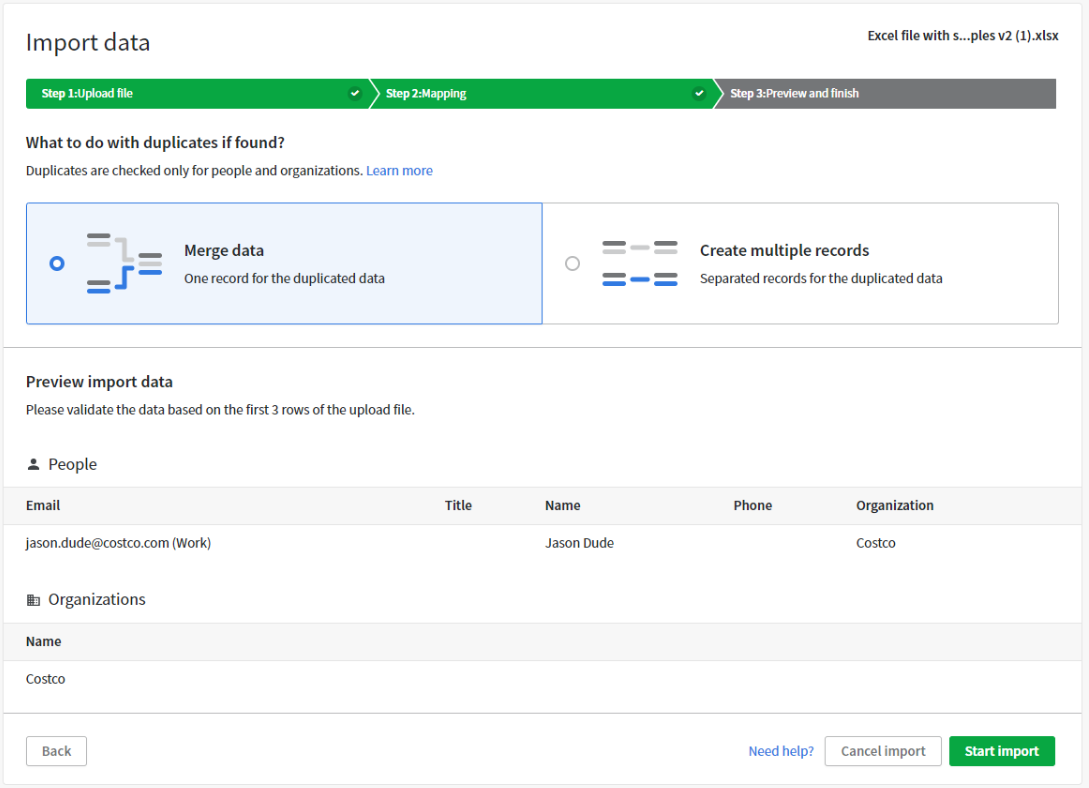
Finally, let’s look at the data preview before it all goes in. You can now review all the contacts you uploaded, any merges Pipedrive made and perform any one off or bulk editing that needs to be done to tidy things up.
Something to keep in mind about how Pipedrive will attempt to map duplicates, if first/last name match for a contact AND organization OR phone OR email match as well, Pipedrive will automatically merge the record. Pipedrive’s rule is good most of the time. But if there are two Jim Smith contacts at the same company then you’ll end up with one contact even though their email addresses and phone numbers are different.
Scrape email signatures & add to Pipedrive
Here is our shameless plug for SigParser.
At this point you’ve got a bunch of contacts in Pipedrive but not all the contacts have details like phone numbers and titles. In reality Pipedrive is still probably missing a lot of the relationships that are key to your business in your CRM.
SigParser is a service which can capture names, phone numbers, titles and more from the email signatures embedded in the emails your team receives. It builds one giant database for your team in the cloud. Then it can automatically add and update Pipedrive contacts.
If you’ve been in business for a while, SigParser can go years into the past to capture all your contacts. For example, SigParser did a 10 year look back for IOS Partners and found 143,000 contacts from just 3 email accounts.
Install the SigParser app for Pipedrive
- Go to the Pipedrive SigParser Marketplace Page and click Install
- You’ll be directed to create a SigParser account
- Connect your email for a free 90 day historical email extract. We’ll build you a database of contacts. You can get buy additional years of history as well.
- Configure SigParser for how it should create and update contacts in Pipedrive
- Review your data and purchase a subscription so SigParser can start pushing data to Pipedrive.
You can connect multiple email accounts if needed. SigParser can be used with a team or just by yourself.
With SigParser your contact data in Pipedrive will stay accurate and up to date without your team having to spend time manually copying and pasting contact data from email signatures.
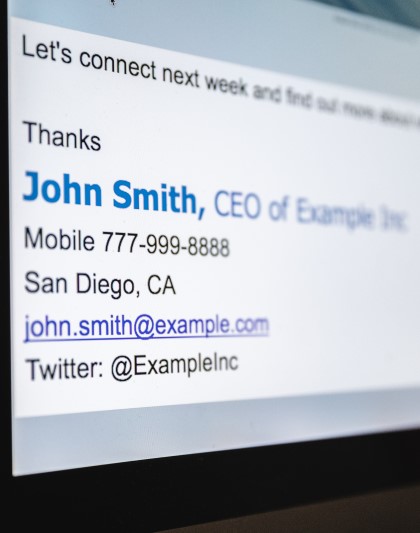
How SigParser Updates Data In Pipedrive
It’s important to know that SigParser will fill in any empty fields in Pipedrive but won’t overwrite any of the data already in Pipedrive. SigParser assumes any data already in Pipedrive was likely entered by a human so it’s likely better.
For example, if Pipedrive already has an office number for a contact and SigParser had a different office number for the same contact, SigParser would not update Pipedrive with the office number it found. However, it will update the same contact with other details it finds that were not already in Pipedrive like a mobile phone number as an example or a title.
This is important because it won’t overwrite any data most likely entered by a human. You can read more detail about SigParser data updates here.
## Dedupe your Pipedrive contacts with [Dedupely](https://dedupe.ly/?utm_source=sigparser&utm_medium=sigparser&utm_campaign=sigparser_pipedrive_import_contacts)
At this point you should have a healthy number of contacts in your Pipedrive instance that both you and Pipedrive have done some initial cleanup on.
Despite this you probably still have a good number of duplicate contacts that are not so obvious or easy to catch in an Excel file.
To solve this issue Dedupely created a great tool that natively connects to Pipedrive and looks at all your contacts to identify duplicates.
Dedupely is incredibly simple to get started with. All you have to do is create a Dedupely account and connect your Pipedrive account for it to being reviewing your data.
Dedupely matches duplicates by presenting you simple lists of contacts that match a specific criteria (i.e. the first and last names are the same but perhaps the email addresses are different). It can also do fuzzy matching for names and other patterns that Pipedrive doesn’t do automatically.
SigParser and Dedupely used together is even more powerful for duplicate cleanup. SigParser will give Dedupley even better data to help identify duplicates and possible merge opportunities.
The Jim Smith example below is a great use case for SigParser and Dedupely used together. The record below is hard to determine if its indeed the same Jim Smith. They could be different people.
If you use SigParser to discover the phone number from your team’s email signatures, Dedupely has more data for identifying the duplicates. The record below has the mobile number for both records, helping Dedupely identify that it’s probably a duplicate. SigParser will help make sure you collect as many contact details as possible to enrich Dedupely and Pipedrive.
Once you completed all the steps, you will have a comprehensive and high quality contact list of duplicate free contacts.
Day 2, now your data is out of date…
CRM data eventually gets stale. It’s just a fact of life, but modern technology is making it easier to manage how well you can keep it up to date in an automated fashion.
Tools like SigParser and Dedupely have just as much ongoing value as they do in helping with the initial data load of Pipedrive.
They help ensure your Pipedrive instance is always up to date with almost no manual data entry.
Remember, your CRM is only as valuable as the data it contains.

